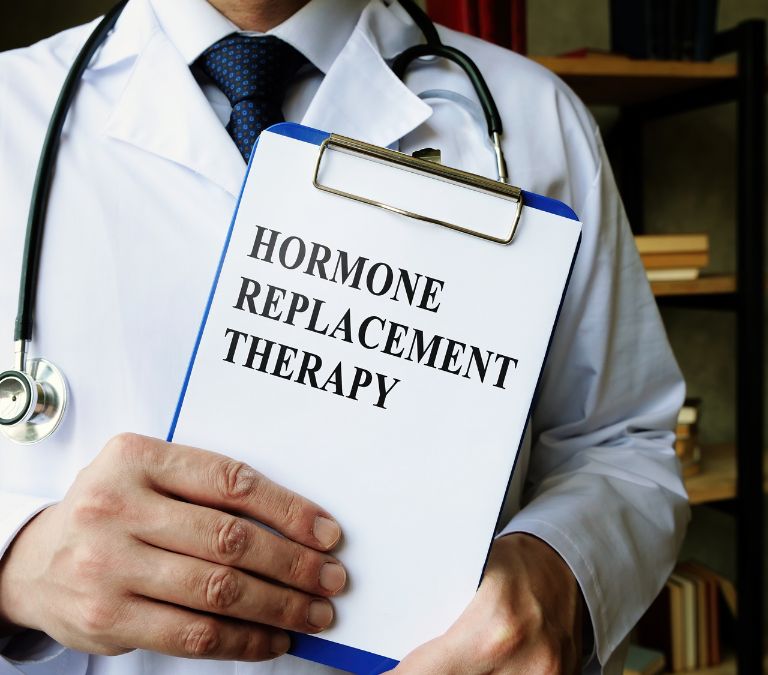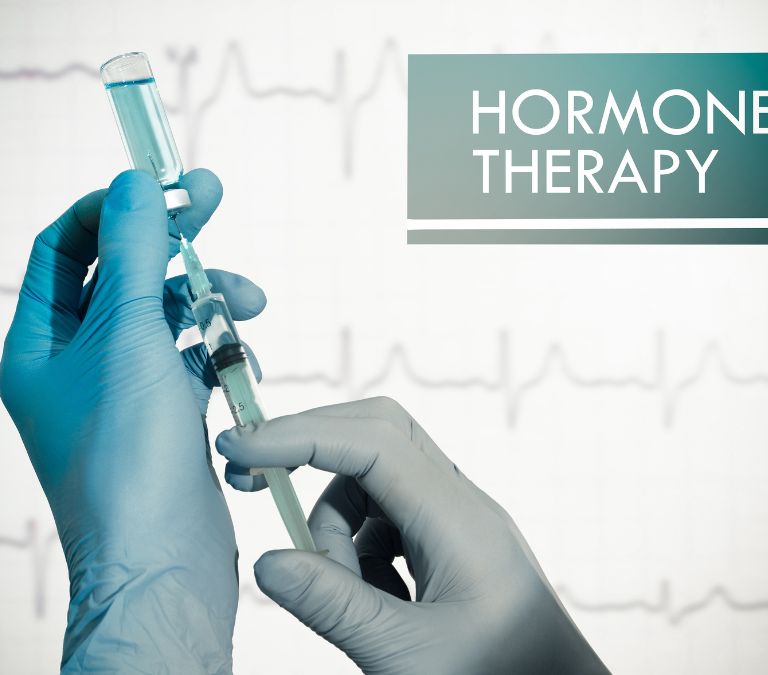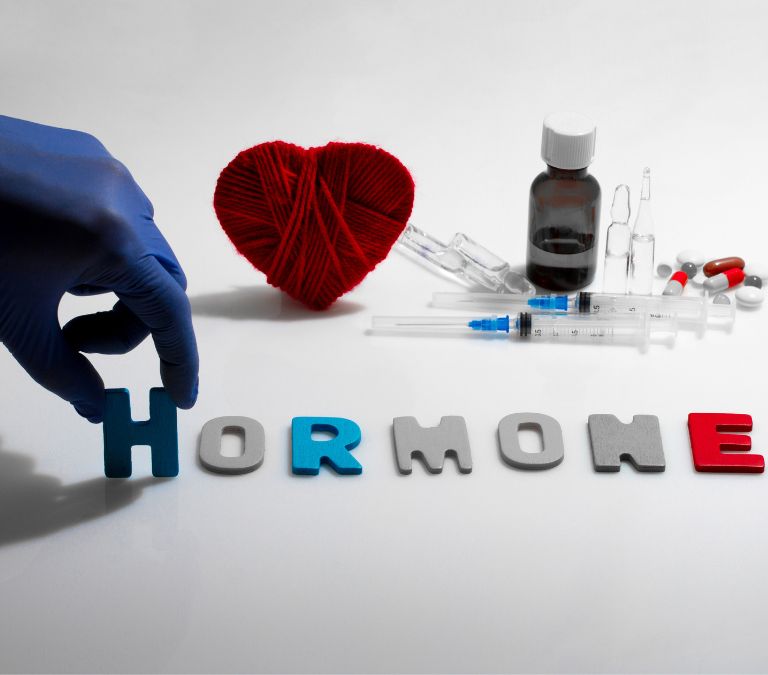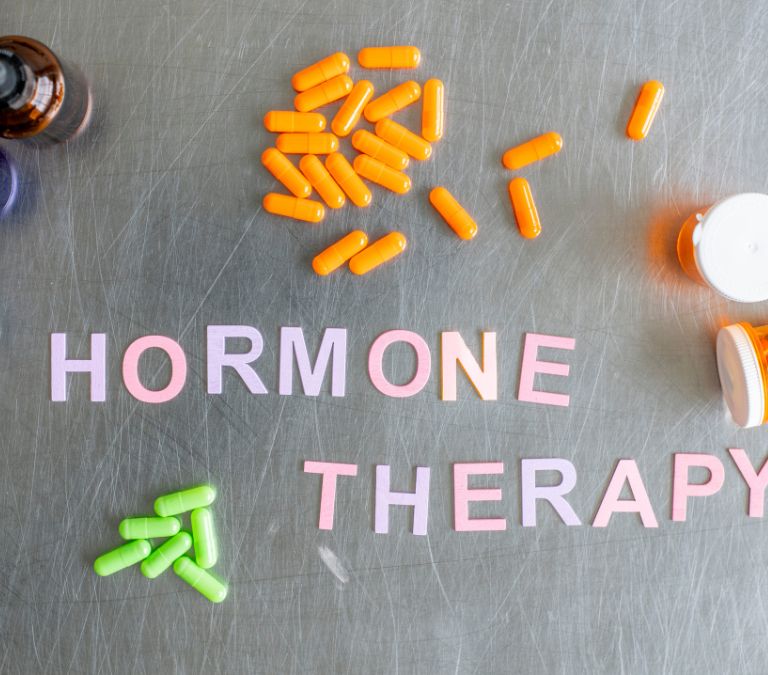The arrival of menopause generally signals the end of a woman’s menstrual cycle. It happens when you stop ovulating and your ovaries stop producing Estrogen. Menopause is a natural occurrence that marks the end of the reproductive years, like the first menstrual period during puberty marks the beginning.
Many, but not all, experience unpleasant symptoms before and after menopause, such as hot flashes, night sweats, changes in mood, and vaginal dryness. These symptoms and physical changes are managed in various ways. Such ways include lifestyle changes such as healthier eating, increased exercise, and hormone replacement therapy (HRT). In this article, we will be discussing how Hormone replacement therapy for menopause, the side effects, the cost, the advantages and disadvantages, and so on.
Hormone replacement therapy (HRT) is a medication containing female hormones. The drug replaces the Estrogen your body stops producing during menopause. HRT is most commonly used to treat menopausal symptoms such as hot flashes and vaginal discomfort. Hormone replacement therapy has also been shown to reduce bone loss and fracture risk in postmenopausal women.
However, as with most other therapies, hormone replacement therapy has drawbacks. These risks vary depending on the type of hormone replacement therapy, the dose, the length of time the medication is taken, and your health risks. HRT should be tailored to the specific individual and re-evaluated regularly to ensure that the benefits outweigh the risks.
What Is Hormone Replacement Therapy?

Estrogen levels decrease during menopause. Some women experience symptoms like hot flashes and vaginal dryness. HRT replaces the hormones that our body no longer produces due to menopause. Two of the most common hormones used in HRT are:
- Estrogen: types used include estradiol, estriol, and estrone
- Progestogen: Either a synthetic version of the hormone progesterone or a version called micronized progesterone that is chemically identical to our hormone.
HRT entails taking just Estrogen (estrogen-only therapy) or both of these hormones (known as combination therapy).
- Estrogen Therapy
If you have symptoms of menopause after surgery to remove the uterus or to remove the uterus, fallopian tubes, and ovaries, doctors may suggest a low dose of Estrogen. Estrogen comes in a variety of forms. A daily pill and patch are the most common forms of the hormone, but it is also available as a vaginal ring, gel, or spray.
- Estrogen pill: Pills are one of the most common treatments for menopausal symptoms. It would help if you took doses according to your doctor’s instructions. The majority of estrogen pills are taken once daily, without food. Some have more complex dosing regimens.
- Estrogen patch: The patch is applied to the skin on your abdomen. Depending on the dose, some patches must be replaced every few days, whereas you can wear some patches for up to a week.
- Topical Estrogen: Other ways to get Estrogen into your system include creams, gels, and sprays. This type of estrogen treatment, like patches, is absorbed through the skin and directly into the bloodstream. The specifics of applying these creams vary, but they are typically used once a day.
- Vaginal Estrogen: Vaginal Estrogen is available as a cream, a vaginal ring, or vaginal estrogen tablets. These treatments are intended for women who experience vaginal dryness, itchiness, burning, or pain during intercourse. Dosing regimens differ depending on the product. The majority of vaginal rings are replaced every three months. Vaginal tablets are frequently used daily for a few weeks before being reduced to twice a week. Creams can be used daily, several times per week, or on a different schedule.
- Estrogen/Progestin hormone replacement therapy
This method is known as combination therapy because it combines Estrogen and progestin, a synthetic form of progesterone. It is intended for women who still have a uterus. Taking Estrogen with progesterone reduces your risk of endometrial cancer, which is the lining of the uterus, compared to taking Estrogen alone. While progesterone is most commonly used as a form of birth control, it can also help treat many menopausal symptoms, such as hot flashes.
- Oral progestins: Many doctors now use natural progesterone instead of synthetic progestins to treat postmenopausal patients. Natural progesterone doesn’t negatively affect lipids, making it a good choice for women with high cholesterol levels.
- Progestin IUD: In the United States, these are approved for pregnancy prevention and bleeding control, and they are sometimes used with Estrogen. If you have one of these IUDs as you enter perimenopause, your doctor may advise you to keep it until the end of perimenopause to help with irregular periods.
10 Signs That Prove You May Need Hormone Replacement Therapy For Menopause

Hormone replacement therapy is not for everyone, but for some, it provides relief from menopausal symptoms.
- Hot flashes: Hot flashes are common during menopause. They cause us to experience a sudden feeling of heat in the upper body. The sensation could begin in the face, neck, or chest and move upward or downward. A hot flash can also cause sweating and red patches to form on the skin.
- Night sweats: Night sweats are episodes of extreme perspiration that may soak your nightwear or bedding and are caused by a medical condition or illness. Night sweats are generally associated with fever, weight loss, localized pain, cough, diarrhea, and other troubling symptoms.
- Vaginal dryness: Perimenopause may signal the start of vaginal dryness, itching, and discomfort, which can last into menopause. Chafing and discomfort during vaginal sex may occur if you have these symptoms. Furthermore, if the skin breaks, the risk of infection increases. Atrophic vaginitis, characterized by thinning, drying, and inflammation of the vaginal wall, can occur during menopause.
- Pain, itching, or burning sensation during sex: As estrogen levels decrease as women approach and pass menopause, the drying and thinning of vaginal tissues can make penetration and intercourse unpleasant for many women. The discomfort can range from a sense of dryness to vaginal “tightness” to severe pain during sex. Some women experience soreness or burning in their vulva or vagina after sex. Without treatment, the inflammation caused by infrequent sex without adequate vaginal lubrication can result in tearing and bleeding of vaginal tissues during intercourse.
- Bone loss: Increased bone loss is caused by the drop in estrogen levels during menopause. It is estimated that in the first five years after menopause, women could lose up to 10% of their bone mass. Since Estrogen is vital in maintaining bone strength and estrogen levels fall during menopause, resulting in increased bone loss.
- Low sex drive: As you approach menopause, you may notice that your libido, or sexual drive, shifts. This libido decline does not affect all women, but it is widespread. In most cases, a decrease in libido during menopause is caused by a drop in hormone levels.
- Mood changes: Menopause can cause mood swings, anxiety, and decreased energy. This mood change is due to the body’s adjustment to the decrease in estrogen and progesterone levels. Sleep deprivation caused by night sweats can also cause mood swings.
- Irritability: Hormone changes in the years before menopause (perimenopause) can lead to irritability and depression, and anxiety. Changes in hormonal levels can also cause various physical issues such as hot flashes, night sweats, disrupted sleep patterns, and weight gain, all of which can impact mental health.
- Sleep problems: Sleep issues can occur during menopause, and they can be caused by anxiety, night sweats, and an increased desire to urinate
- Chills: A hot flash is something you’ve probably heard of. Cold flashes or Chills, which are sometimes associated with hot flashes, are less common. Chills are a tingling, shivery, cold sensation that can sweep over your body unexpectedly. It may even cause you to tremble or turn pale. A hard flash is usually brief, lasting only a few minutes.
Aside from using Hormone replacement therapy for menopause, it could also help with other conditions caused by a lack of hormones.
Undergoing HRT (hormone replacement therapy) may help women:
- Relieve hot flashes and night sweats
- Sleep better
- Ease vaginal dryness and itching
- Make sex less painful
- Smoothen out mood swings
- Make some women less likely to have heart disease
- Lower the chances of dementia
HRT also lowers the risk of a variety of chronic conditions that can affect postmenopausal women, such as:
- Diabetes: Taking HRT around menopause lowers a woman’s risk of developing diabetes.
- Osteoporosis: HRT prevents further bone density loss, preserves bone integrity, and lowers the risk of fractures, but it is not usually recommended as the first line of treatment for osteoporosis, except in younger postmenopausal women (under the age of 60).
- Bowel cancer: HRT reduces the risk of bowel cancer.
- Cardiovascular disease: When used around menopause, HRT has been shown to reduce cardiovascular disease markers.
Side Effects of using hormone replacement therapy for menopause
Hormone replacement therapy, like almost all medications, has side effects. Listed are the most common side effects:
- Monthly bleeding
- Unusual spotting.
- Breast sensitivity.
- Mood changes.
- Fluid retention is a less common side effect of hormone replacement therapy.
- Migraines
- Discoloration of the skin (brown or black spots).
- Irritation of the skin beneath the estrogen patch.
These side effects usually reduce after a few weeks. Notifying the doctor of any side effects that cause concern is critical. They may change the dosage or recommend an alternative. You might be wondering if it is secure? Hormone replacement therapy was once widely used during menopause, but it may not be safe or appropriate for everyone, particularly those with specific risk factors. Most doctors now agree that taking hormone replacement therapy is safe:
- For moderate-to-severe hot flashes and vaginal dryness
- Up to the age of 59
- Within ten years of menopause
- At the smallest possible dose and for the shortest possible time duration
However, the decision should be influenced by your overall health and preferences. HRT may not be appropriate for people who have a history of:
- High blood pressure
- Blood clots
- Stroke
- Heart disease
- Breast cancer
- Gallbladder disease
Also, avoid using HRT if you are pregnant or may become pregnant.
Will hormone replacement therapy for Menopause Make You Gain Weight?

The answer is ‘No!’. Hormones produced or supplemented by our bodies can stimulate our appetite. Your weight should not rise if you already watch what you eat and follow a healthy, active routine. During menopause, we naturally gain fat around our midsections, often derisively referred to as ‘belly fat.’ This fat gain is the result of two distinct natural processes. Whether on HRT or not, the stress of hormonal changes that occur as we age leads to visceral fat. Smoking, excess work, relationship issues, or hormonal shifts can cause stress. It stimulates the production of cortisol by our adrenal glands.
On the other hand, cortisol encourages the body to store more fat in our bellies and on the tops of our shoulders. It happens because the fat cells in these areas have four times the cortisol receptors. Fat is noticed with our tummies feeling fatter than the buttocks and legs.
Furthermore, our muscle tone and strength deteriorate as we age, pushing our visceral fat forward. So, if all we see in the mirror is a big stomach, possibly shrunken buttocks, and skinny legs, we need to step back and figure out what’s happening. We can improve things through diet and exercise, with or without hormone replacement therapy, if we desire.
While committing to a regimen of abdominal exercises, such as sit-ups and stomach crunches, can help improve our ‘abs,’ it may not help reduce visceral fat. If we do nothing about our visceral fat, we risk developing other health problems, such as a greater risk of heart disease, stroke, Type II diabetes, and asthma. In addition to exercise, we can reduce visceral fat by limiting our alcohol and processed foods intake.
Excess alcohol calories are stored as fat. Alcohol slows fat burning and metabolism. Trans fats (fats that have had hydrogen added to them to increase the product’s shelf life) are found in processed foods. Thirty minutes of moderate exercise daily can increase our metabolic rate, which aids in removing visceral fat. Maintaining a daily exercise routine that includes aerobic exercise and strength training is essential.
Yoga and pilates are excellent low-impact ways to improve muscle tone, particularly in our core. They also aid in improving balance and reducing stress. Cycling, swimming, walking, and participating in exercise classes can all help us improve our aerobic capacity, strengthen our muscles, and maintain our flexibility.
Night sweats, the need to urinate, or an overactive mind causing restlessness all harm how well we sleep at night for many women. Sleep deprivation or poor-quality sleep has been linked to weight gain. If we can alleviate these symptoms with hormone replacement therapy and improve our sleep quality, this weight gain will become less of an issue. It is possible to have enough mental energy to concentrate on making positive lifestyle changes. However, we can make simple lifestyle changes to accommodate this stage.
We require approximately 200 fewer calories daily than in our thirties and forties. So a diet high in healthy fats and low in carbs allows the body to rest from food (i.e., fasting) is necessary. Pure coconut oil, for example, can be used to fry food or could be included in a smoothie as it can help reduce visceral fat. Phytoestrogens mimic the effects of natural Estrogen in our body: phytoestrogens are found in linseeds, sesame seeds, broccoli, edamame beans, cauliflower, and cabbage. Hence it is beneficial for us to include these foods in our diets.
So, properly prescribed HRT should not result in cause-and-effect weight gain. This period is the time in our lives when our bodies are changing, and our needs and requirements are changing. As a result, we must work with it to provide nutrients and support that will allow it to perform to its full potential.
What’s the Average Cost of Hormone Replacement Therapy?

One of the frequently asked questions about this treatment is the overall cost. While this is a good question, given that most insurance plans do not cover the cost of this treatment, the truth is that hormone replacement therapy is one of the most cost-effective treatments available. Hormone replacement therapy typically costs between $30 and $90 per month. The cost of your treatment will be determined by several factors, including the treatment method you choose and the number of hormones you require in each dose.
The essential cost of HRT only covers hormone replacement therapy. There are additional costs related to these therapies, and I have listed the factors you should consider to make an informed financial decision below.
- Pills: The monthly prescription cost for oral HRT ranges from $130 to $240. However, because most insurance companies cover HRT pills, most people only see their prescription co-pay costs, typically $30 per month.
- Patches, Creams, and Gels: The prices range from $120 to $1,000, but you have a lot more work to do on your own. On the plus side, using creams, gels, and patches may have fewer side effects.
- Injectables: Although some women prefer this method, injectable hormone replacement therapy is primarily used by men. It is one of the costliest options, with some treatments costing several thousand dollars annually and requiring frequent doctor’s appointments.
- Pellets: Pellet therapy is an out-of-pocket expense not typically covered by health insurance. As a result, you will bear the entire cost. The cost is comparable to the other treatments. You pay nearly the same, and there are additional benefits.
Other Factors to Remember about Hormone Replacement Therapy For Menopause
Hormone replacement has multiple different options you can choose from. You may want to say that the pills are your best bet based on the cost of just the prescription. However, keep in mind that there are other factors at play. The cost of the doctor’s visit is not included in the prescription price.
If you have a co-pay for a doctor’s visit, this can quickly add up to hundreds of dollars in additional charges for your therapy. The same is true for bloodwork, which monitors your levels. You must pay for these tests because many insurance companies have annual limits on how many blood tests they cover.
For some women, how frequently you use these options may be a significant factor in driving those medical fees high. Creams and gels can be used by those looking for a more natural application. These should be used several times every day. It is the most cost-effective method, but it is also the most time-consuming.
Injectables are frequently linked to uneven absorption and a roller coaster effect in hormone delivery, leading to high peaks and low valleys. Pellet therapy requires two to four doctor visits per year and no additional work on the part of the patient. Pellet therapy is the only form of Estrogen that is considered long-term and the only hormone replacement therapy that regularly maintains physiological levels in women.
Conclusion On Hormone Replacement Therapy For Menopause
Most women who use hormone replacement therapy as a short-term treatment of menopausal symptoms believe that the benefits outweigh the risks. The lowest effective HRT dose is used, and the clinical reasons for use should determine the duration. HRT is still approved for osteoporosis prevention and is the treatment of choice for women starting treatment before age 60, particularly those experiencing premature menopause.
Women on HRT should be re-evaluated by their doctor at least once a year. Long-term HRT use is required for some women to maintain symptom relief and quality of life. Despite the risks of HRT, it is still the best way to treat severe menopausal symptoms and improve quality of life. You can talk further about the risks and benefits with your doctor or a trained specialist, as well as discuss other treatment options.







